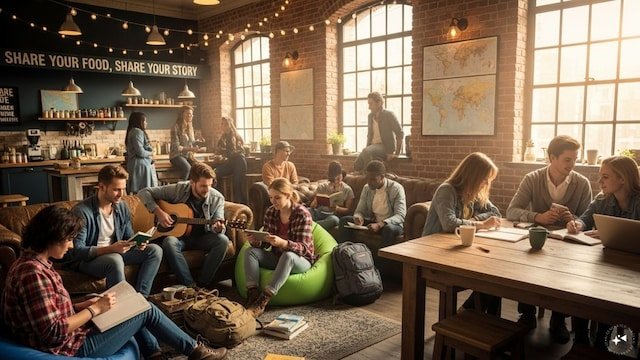Travel Trends
From Sightseeing To Stillness: Why Slow Travel And Hostels Are The New Travel Luxury | Travel News

Last Updated:
As millennials and Gen Z look out for slow travel opportunites, the hostel culture is becoming one of the most hottest travel trends.
Millennials and Gen Z favour slow travel, seeking meaningful experiences over quick sightseeing.
There was a time when travel meant ticking landmarks off a list, snapping selfies in front of monuments, and rushing from one itinerary checkpoint to another. But a quiet shift is underway, one that’s replacing “how much did you see?” with “how deeply did you feel?”
Enter the era of slow travel, a rising movement where young adults, especially Gen Z and millennials, are choosing depth over distance. Think reading in a hammock while it rains outside, hiking misty trails at your own pace, or simply doing nothing at all without guilt. The journey now is less about covering ground and more about grounding oneself.
At the centre of this transformation is the hostel culture, reimagined not as just affordable accommodation, but as a canvas for connection and culture. “Hostels are no longer just about beds; they’re about bonfire nights, book corners, chai sessions with strangers-turned-friends, and the freedom to just be,” says Pranav Dangi, CEO & Founder of Hosteller.
With cosy lounges, reading nooks, nature-view balconies, and community events, hostels have become sanctuaries for travellers seeking stillness over speed. During the monsoons, this culture comes alive in ways no checklist ever could. Picture sipping coffee in a hillside hostel as rain dances on the windows, or sharing stories with fellow travellers around a crackling fire. It’s not about seeing everything, it’s about feeling something real.
With communal lounges, reading nooks, and scenic balconies, hostels offer an inviting setting for travellers to unwind, share stories, or simply soak in their surroundings. During the monsoons, this culture blooms. From hillside hostels drenched in mist to shared treks through dew-covered forests, these stays transform a trip into a sensory escape. “When you pause and let the rain slow you down, that’s when the real travel begins,” Dangi shares.
There’s a psychological comfort that hostels provide, a rare blend of solitude and social connection. “More young travelers are now choosing hostels because they offer something most hotels don’t: human connection and creative freedom,” Dangi notes. This isn’t about five-star indulgence, but about making meaningful memories.
top videos
Jennifer Lopez Turns Fashion Faux Pass Into A Viral Moment; 4 Times Stars Handled It Like Pros
ICW 2025: Victoria’s Secret Angel Alessandra Ambrosio Turns Showstopper For Manish Malhotra
Pedro Pascal’s Intimate Gestures With Pregnant Vanessa Kirby Spark Backlash & Heated PDA Debate;N18G
Netflix Not Renewing Meghan Markle & Prince Harry’s $100 Million Deal | What Went Wrong? | N18G
Uorfi Javed’s Swollen Face Sparks A Meme Fest But She Shares The Candid Truth Like A Pro
As Dangi explains, “More young travelers are now choosing hostels because they offer something most hotels don’t: human connection and creative freedom.” Whether it’s journaling in silence, jamming on a rooftop at sunset, or going on impromptu treks, hostels now enable more than travel; they enable presence.
What’s unfolding is not a fleeting trend but a redefinition of what it means to wander. In this new rhythm of travel, hostels are no longer pit stops; they’re places to pause, reflect, and reconnect.
- Location :
Delhi, India, India
- First Published:
Travel Trends
Visa, Mastercard set for higher profits on solid spending trends — TradingView News
Visa V and Mastercard MA are expected to report higher quarterly profits this week on steady consumer spending, and analysts will scrutinize how demand for travel and discretionary purchases is shaping up in the face of tariff uncertainty.
The results from the world’s biggest payment processors will help flesh out the broader financial outlook that major banks such as JPMorgan Chase JPM and Wells Fargo
WFC presented earlier this month, signaling a resilient consumer.
“Visa and Mastercard remain top ideas, particularly in an uncertain macro environment, given their broad-based exposure to discretionary and non-discretionary spend, geographic reach, and proven ability to stabilize their expense increase in downturns,” Oppenheimer analysts said in a note.
Billions of people worldwide use Visa and Mastercard for their everyday spending and other purchases, making the card networks better equipped to weather downturns. They also have more expense flexibility to support profit growth.
In recent years, the companies have diversified their business model by building out value-added services such as threat intelligence and fraud reduction.
Still, some analysts expect a potential spending slowdown in the back half of 2025. Cross-border travel, a high-margin business for payments companies, has come under some pressure due to trade tensions and geopolitical risks.
Slower travel from Canada to the U.S. and fresh tensions in the Middle East in June have raised concerns over a potential drag on growth.
Analysts will also examine whether elevated volumes are being driven by a pull-forward in spending, as consumers pre-purchase goods they expect to get costlier after tariffs are imposed.
In the second quarter, total card spending volumes modestly increased across bank issuers. Across credit and debit cards, Bank of America BAC showed an increase of 110 basis points, while JPMorgan Chase showed a 40 bps rise, according to data compiled by RBC Capital Markets.
“On balance and relative to expectations, data seems neutral for the networks and acquirers, considering overall spending trends appear at least stable compared to last quarter’s growth, which we think should be good enough considering the macroeconomic volatility since last quarter’s earnings,” J.P. Morgan analysts said in a note.
Investors will also zero in on the forecast around stablecoins. While both the card giants plan to launch products linked to the cryptocurrency, the recent passing of the Genius Act has raised some concern that stablecoins could eliminate the need for payment intermediaries in the long term.
Visa, the larger of the two by market value, will announce quarterly results after markets close on Tuesday, while Mastercard will report on Thursday.
American Express AXP surpassed quarterly profit expectations earlier this month, helped by resilient spending by its affluent customer base.
Visa and Mastercard shares have gained nearly 13% and 8% year-to-date as of Friday’s close, respectively, while the benchmark S&P 500 index SPX has gained 8.6%.
|
Company |
EPS estimates |
Year-ago |
|---|---|---|
|
Visa |
$2.85 |
$2.42 |
|
Mastercard |
$4.03 |
$3.59 |
Source: LSEG, Company Statements

Travel Trends
Why Americans Are Choosing the Road Over Air Travel This Year, A Shift in Vacation Trends Amid Trips Anxiety, New Update is Here

Monday, July 28, 2025
In 2025, the open road is calling again. As air travel anxiety continues to rise, and burnout drives many Americans to escape their routines, the allure of a road trip is stronger than ever. According to a survey of 1,000 U.S. travelers, more and more people are choosing to drive instead of fly. This shift in travel behavior is due to a variety of factors, including fears surrounding air travel safety, the desire to relieve stress, and the flexibility offered by road trips. With 45% of travelers citing recent airline issues as a reason to drive, the 2025 summer travel season has seen a noticeable increase in road trips, reshaping how Americans are approaching their vacations.
As more people opt for road trips, this growing trend is not only redefining what a summer getaway looks like but also creating significant shifts in the tourism industry. From shorter routes and packed coolers to unique detours and fresh playlists, road trips are no longer the long-haul journeys they once were. In this article, we explore the rise of road trips in 2025, examining why Americans are reclaiming the road, the new trends in road trip destinations, and how these shifts are impacting the tourism industry.
The Rise of Road Trips: Why Americans Are Driving Instead of Flying
Americans are hitting the road in record numbers, and it’s not just about the freedom of the open highway. The ongoing anxiety surrounding air travel has played a significant role in this shift. According to the survey, 45% of Americans say recent airline crashes and malfunction coverage have pushed them to choose road trips over flights this summer. These fears are especially pronounced among younger generations, with 80% of Gen Z and 60% of millennials avoiding air travel. As news of airline incidents circulates, many travelers feel that driving provides more control and peace of mind.
Along with safety concerns, many Americans are turning to road trips to combat stress and burnout. Nearly 40% of travelers are choosing the open road as a way to disconnect from their daily routines and recharge. This trend of seeking emotional escape is fueling the growing popularity of shorter, more manageable road trips that offer the flexibility to take detours and stop at unplanned destinations.
A Shift Toward Shorter Road Trips: Changing the Definition of Summer Travel
One key trend in 2025 road trips is that Americans are keeping their journeys closer to home. In the past, long cross-country drives were a staple of road trip culture, but today, 60% of travelers are planning trips within 500 miles of their homes. This shift indicates a redefinition of what a road trip means, with many opting for shorter, more accessible routes that allow for quick getaways without the stress of long driving hours.
Despite the focus on shorter distances, the multi-day road trip is still alive and well. While fewer people are embarking on long-haul drives, only 4% of respondents said they were planning a one-day trip. This suggests that the appeal of a road trip still lies in its ability to offer a change of scenery and a break from the everyday grind, even if it’s within a more manageable distance.
Who’s Hitting the Road? Road Trip Partners and Solo Travelers
When it comes to who’s hitting the road, companionship is key for most American travelers. A majority of road trippers (86%) will travel with others, and 89% of these include pets in their journey. However, there is a noticeable difference in travel preferences between generations. Gen Z, in particular, is more likely to go solo, with nearly 1 in 5 planning to travel alone. This is a stark contrast to baby boomers, where only 7% choose to embark on solo trips.
The rise of solo road trips among Gen Z speaks to a desire for independence and personal exploration, while older generations are more inclined to travel with family or friends. Despite these generational differences, the road trip remains a shared experience for most travelers, offering both freedom and connection with loved ones.
Accommodations on the Road: The Shift from Hotels to Home Rentals
Traditionally, road trippers have relied on hotels and motels for overnight stays, but that norm is changing. In 2025, 1 in 5 travelers are opting for home rentals through platforms like Airbnb and VRBO, bringing added comfort and convenience to their road trip experiences. Gen Z is leading this trend, with 33% of this generation now preferring home rentals—triple the rate of baby boomers, who still prefer traditional hotels.
This shift in accommodation preferences reflects the growing desire for more personalized and flexible travel experiences. Home rentals offer travelers the opportunity to stay in unique, private properties that allow them to feel more at home while on the road. Whether it’s a cozy cabin in the woods or a beachfront villa, these types of accommodations are becoming an increasingly popular choice for road trippers seeking a different kind of adventure.
How Road Trips Are Helping Americans Manage Their Travel Budgets
As travel costs continue to rise, many Americans are turning to road trips as an affordable alternative to flying. According to the survey, packing meals is one of the top ways to cut road trip costs, with 40% of travelers skipping restaurants to save money. The ability to control expenses is one of the main draws of a road trip, as it allows for greater flexibility in budgeting.
In addition to packing food, travelers are also avoiding toll roads and cities with expensive parking fees. Many are choosing shorter trips or sharing costs with travel companions to keep expenses manageable. Interestingly, while gas prices remain a concern for road trippers, 26% of travelers are continuing with their plans despite higher fuel costs. This indicates that the freedom and flexibility of road trips outweigh the financial challenges for many Americans.
The Role of Music and Technology in the Road Trip Experience
A road trip wouldn’t be complete without the perfect playlist. The survey revealed that Rihanna is the #1 artist Americans want to listen to during their road trips, surpassing Taylor Swift and Beyoncé. Music plays a critical role in creating the road trip experience, setting the tone for the journey and adding to the sense of adventure.
In addition to music, technology is transforming how Americans plan and experience their road trips. Many travelers are using apps to map out their routes, find lodging, and explore new destinations. Gen Z, in particular, is heavily reliant on tech, using AI tools like ChatGPT to plan their trips, research destinations, and prepare packing lists. While older generations may still rely on traditional methods, technology is playing an increasingly important role in how travelers navigate the open road.
Road Trip Fears and Challenges: Overcoming Travel Anxiety
While road trips offer a sense of freedom, they also come with their own set of anxieties and challenges. Car troubles are the top concern for 27% of Americans, while high gas prices and long driving hours are also sources of stress. Despite these challenges, road trippers are finding ways to manage their fears. For example, many are opting for roadside assistance programs to help with breakdowns, while others are shortening their trips to save on fuel costs.
Interestingly, Gen Zers have different road trip anxieties compared to other generations. While car troubles are a concern for many, only 17% of Gen Zers fear vehicle issues, compared to 27% of the general population. This suggests that younger travelers may be more confident in their ability to handle potential road trip challenges.
Conclusion: The Revival of the Road Trip in 2025
In 2025, road trips are not just a nostalgic pastime—they are a critical part of how Americans are choosing to travel. With fears surrounding air travel, the desire to escape burnout, and the appeal of flexibility, more travelers are opting for the open road. Whether it’s a short trip to a nearby national park, a solo adventure, or a family getaway, the road trip offers a sense of freedom and adventure that flying simply can’t match.
As the travel industry continues to evolve, the road trip is redefining the way Americans approach vacations. With music, technology, and budget-friendly solutions enhancing the experience, the open road is calling, and Americans are answering in record numbers. For many, it’s not just about the destination—it’s about the journey.
Travel Trends
AI Travel Planning : Backpackk

Backpackk’s price comparison feature has the ability to scan multiple sources to help users find competitive rates. Additionally, the platform offers a social element where travelers can share their itineraries on personal profiles, potentially inspiring others in the community. For businesses, Backpackk represents a convergence of AI personalization, multi-service integration, and user-generated content within the travel industry, reflecting trends toward streamlined planning experiences and peer-to-peer sharing.
Image Credit: Backpackk
-

 Brand Stories1 week ago
Brand Stories1 week agoBloom Hotels: A Modern Vision of Hospitality Redefining Travel
-

 Brand Stories2 days ago
Brand Stories2 days agoCheQin.ai sets a new standard for hotel booking with its AI capabilities: empowering travellers to bargain, choose the best, and book with clarity.
-

 Destinations & Things To Do1 week ago
Destinations & Things To Do1 week agoUntouched Destinations: Stunning Hidden Gems You Must Visit
-

 AI in Travel1 week ago
AI in Travel1 week agoAI Travel Revolution: Must-Have Guide to the Best Experience
-

 Brand Stories3 weeks ago
Brand Stories3 weeks agoVoice AI Startup ElevenLabs Plans to Add Hubs Around the World
-

 Brand Stories2 weeks ago
Brand Stories2 weeks agoHow Elon Musk’s rogue Grok chatbot became a cautionary AI tale
-

 Destinations & Things To Do2 days ago
Destinations & Things To Do2 days agoThis Hidden Beach in India Glows at Night-But Only in One Secret Season
-

 Asia Travel Pulse3 weeks ago
Asia Travel Pulse3 weeks agoLooking For Adventure In Asia? Here Are 7 Epic Destinations You Need To Experience At Least Once – Zee News
-

 AI in Travel3 weeks ago
AI in Travel3 weeks ago‘Will AI take my job?’ A trip to a Beijing fortune-telling bar to see what lies ahead | China
-

 Brand Stories3 weeks ago
Brand Stories3 weeks agoChatGPT — the last of the great romantics












You must be logged in to post a comment Login